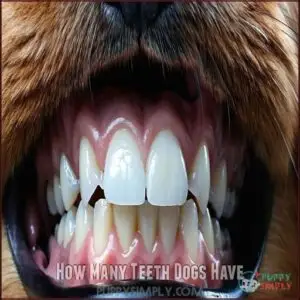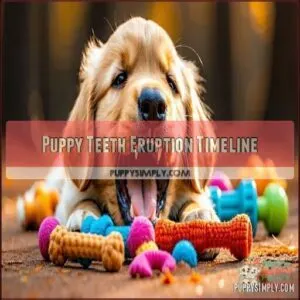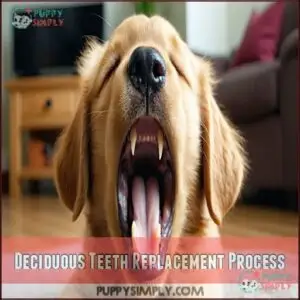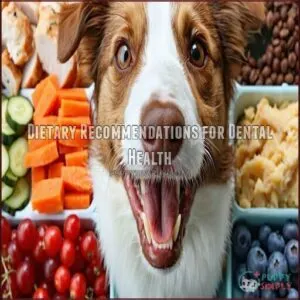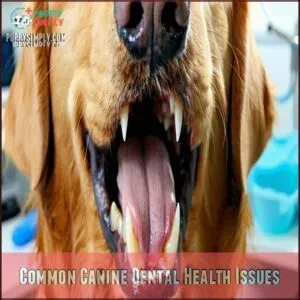This site is supported by our readers. We may earn a commission, at no cost to you, if you purchase through links.

Your furry friend’s dental arsenal includes incisors, canines, premolars, and molars—each designed for specific tasks from nibbling to tearing and grinding.
Puppies start with just 28 deciduous (baby) teeth that fall out between 3-6 months of age as their permanent teeth emerge.
You might even find these tiny teeth around your home as your pup sheds them, or they might swallow them during mealtime.
Proper dental care can prevent the painful problems that plague nearly 80% of dogs by age three.
Table Of Contents
- Key Takeaways
- Dog Teeth Overview
- How Many Teeth Dogs Have
- Dog Teeth Development
- Dog Dental Health Importance
- Maintaining Canine Dental Health
- Frequently Asked Questions (FAQs)
- How many teeth does a puppy have?
- What is the average number of teeth an adult has?
- How many permanent teeth does a dog have?
- Do all dogs have the same number of teeth?
- What kind of teeth do dogs have?
- How many types of canine teeth are there?
- Are dogs happier after tooth extraction?
- Do dogs have teeth?
- What are the different types of dog teeth?
- How many molars does a dog have?
- Conclusion
Key Takeaways
- Adult dogs have 42 permanent teeth (10 more than humans), including incisors, canines, premolars, and molars—each designed for specific tasks from nibbling to tearing and grinding food.
- Your puppy begins life toothless and develops 28 deciduous teeth between 3-10 weeks of age, which fall out between 3-7 months as their permanent teeth emerge.
- Nearly 80% of dogs develop periodontal disease by age three, making regular brushing with dog-safe toothpaste and annual veterinary dental cleanings essential for your pet’s overall health.
- You’ll need to watch for signs of dental problems like bad breath, bleeding gums, or facial swelling, and understand that small breeds often face higher risks of dental issues than larger dogs.
Dog Teeth Overview
You’ll find that your adult dog has 42 permanent teeth, substantially more than your own 32 human teeth.
Adult dogs sport an impressive 42 teeth—10 more than humans—designed for nibbling, tearing, and grinding with precision.
These teeth include incisors for nibbling, canines for tearing, premolars for shredding, and molars for grinding food.
Adult Dog Dental Anatomy
Your adult dog’s dental formula is impressive – 42 permanent teeth in total, that’s 10 more than you have.
The jaw tooth count breaks down to 20 teeth in the upper jaw (maxilla) and 22 in the lower jaw (mandible).
Most breeds share this standard dog teeth number, though Chow Chows are unique with 44 teeth.
Tooth eruption typically completes between 3-7 months of age.
Maintaining this dental formula requires consistent dog dental care and understanding the importance of dental formula and consistent care.
Puppy Dental Development
While adult dogs boast 42 teeth, puppies start life completely toothless.
Your puppy’s dental development follows a predictable pattern as they grow.
Puppy teeth eruption typically follows this timeline:
- Birth to 2 weeks: No visible teeth
- 3-4 weeks: First deciduous teeth appear
- 8-10 weeks: All 28 puppy teeth present
During teething, you’ll notice your puppy chewing everything in sight.
Breed variations exist, with smaller breeds sometimes developing teeth more slowly than larger ones, which can affect their overall dental development and lead to a unique set of teeth.
Types of Dog Teeth
Your dog’s mouth consists of four distinct tooth types, each serving a unique purpose.
Incisors (12 total) help with nibbling and grooming. Canines (4 total) tear food and defend. Premolars (16 total) shear tough materials. Molars (10 total) handle grinding and crushing.
Together, these 42 teeth form your dog’s complete dental arsenal, though breed variations exist—Chow Chows actually have 44 teeth, which is a notable exception to the typical 42 teeth and highlights the importance of understanding your dog’s specific dental arsenal.
How Many Teeth Dogs Have
You’ve probably wondered how many teeth your furry friend actually has while playing tug-of-war or watching them crunch kibble.
The typical adult dog has 42 permanent teeth—significantly more than our human count of 32. This dental formula remains consistent across most breeds, regardless of jaw size or diet impact.
- Adult dogs possess 20 teeth in their upper jaw (maxilla) and 22 in their lower jaw (mandible)
- The canine dental formula includes 12 incisors, 4 canines, 16 premolars, and 10 molars
- Chow Chows are unique with 44 teeth, making them dental anomalies in the dog world
- Small and large breeds alike generally maintain the standard 42-tooth count
- Puppies initially have only 28 deciduous teeth before their adult set develops
Understanding your dog’s teeth count helps you better monitor their dental health and spot potential tooth anomalies that might require veterinary attention.
Dog Teeth Development
Your puppy’s teeth follow a predictable growth pattern from birth to adulthood, starting with no teeth at birth and progressing to a full set of 42 adult teeth by about 7 months of age.
You’ll notice your dog’s baby teeth (only 28 of them) fall out between 3-5 months, making way for the permanent teeth that will serve them throughout their life.
Puppy Teeth Eruption Timeline
During the first few weeks of life, your puppy’s teeth begin their journey to the surface. By 3 weeks, incisors and canines emerge first, followed by premolars, completing all 28 deciduous teeth by 6-8 weeks.
Teething signs include red gums and increased drooling. To alleviate discomfort, provide appropriate durable chew toys.
Timeline deviations occur between breeds—larger breeds often complete eruption stages faster than smaller ones. Watch for retained teeth that might require veterinary attention during puppy tooth development, which can be a critical issue.
Deciduous Teeth Replacement Process
Between months 3-7, your puppy’s deciduous teeth make way for permanent ones through root resorption.
Baby teeth typically fall out in the same order they erupted, with incisors going first around 4 months, followed by canines at 5-6 months, and premolars by 6-8 months.
Breed variations exist, with small dogs sometimes experiencing slower tooth development.
Watch for teething signs like increased chewing and potentially retained deciduous teeth requiring veterinary attention.
Adult Teeth Development Stages
Your adult dog’s permanent dentition begins developing around 3-4 months of age.
The eruption timeline typically spans 3-7 months, with canines emerging at 5-6 months and premolars/molars following at 5-8 months.
By 8 months, your puppy should have their full mouth of 42 adult teeth.
Some breed variations exist—Chow Chows have 44 teeth, differing from the standard dog dental formula.
Dog Dental Health Importance
You’ll need to care for your dog’s 42 teeth just as you care for your own, as over 80% of dogs develop periodontal disease by age three.
Regular brushing, proper chew toys, and annual veterinary dental cleanings help prevent painful infections that can affect your pet’s overall health.
Regular Brushing and Oral Exams
Brushing your dog’s teeth regularly forms the cornerstone of good canine dental health. You should examine your dog’s mouth weekly and brush their teeth daily using proper brushing techniques for ideal dog oral hygiene.
- Use circular motions when brushing, focusing on the gum line where plaque accumulates
- Schedule professional dental exams every 6-12 months
- Learn to perform basic home assessments by checking for bad breath, swollen gums, or discolored teeth to ensure proper brushing techniques.
Dental Cleanings and Preventative Care
Much like your routine check-ups, your dog needs professional dental cleanings too.
These cleanings remove tartar buildup that home dentalcare can’t reach.
Professional dental cleanings for dogs typically take 30-60 minutes and involve scaling and polishing to prevent periodontal disease.
Early intervention through regular cleanings can save money by avoiding complex treatments later.
Like humans, dogs benefit from regular professional cleanings to maintain ideal oral health.
Special dental diets can also support your pup’s oral health between vet visits.
Choosing Right Toothpaste and Brush
Now that you understand the importance of regular dental cleanings, selecting the right tools makes all the difference.
Never use human toothpaste for your dog as it contains xylitol, which is toxic to them.
When choosing dog toothpaste and toothbrushes, remember these key points:
- Pick the right brush size that matches your dog’s mouth dimensions
- Select softer bristle firmness for sensitive gums
- Find flavor preferences your pup enjoys (like chicken or beef).
Many owners explore available flavors to find one their dog loves.
Maintaining Canine Dental Health
You’ll need to take care of your dog’s 42 teeth to prevent dental disease, which affects over 80% of dogs by age three.
Regular brushing with dog-safe toothpaste and yearly veterinary dental cleanings will help maintain your pet’s oral health and prevent painful problems.
Dietary Recommendations for Dental Health
Now that you’ve learned about the importance of dental care, let’s look at how diet affects your dog’s 42 teeth.
What your pup eats directly impacts their dental health. Choose dental diet types that minimize plaque buildup.
Dental chews and appropriate chew toys impact teeth cleaning naturally. While the raw food debate continues, focus on hydration importance as well.
A specialized dog dental diet can substantially improve oral hygiene. Proper supplement considerations can support those chompers for years to come.
Common Canine Dental Health Issues
While the right diet supports your dog’s teeth, dental problems can still arise.
Periodontal disease affects over 80% of dogs past age three, starting as plaque before hardening into tartar.
Your dog may develop gingivitis (reversible gum disease), tooth fractures from chewing hard objects, or painful oral abscesses.
Small breeds face higher risks of these dog dental problems.
Watch for bad breath, bleeding gums, or facial swelling—all warning signs requiring attention.
Veterinary Dental Care and Exams
Having spotted dental issues early, your next step is regular veterinary dental care. Schedule professional cleanings once yearly—more often for small breeds.
Your vet will examine all 42 dog teeth, take dental X-rays, and clean under anesthesia.
Regular cleanings address hidden dental issues not visible at home.
While anesthesia risks exist, they’re minimal compared to untreated dental disease. Some dogs may need oral surgery to remove damaged teeth, ensuring your pup’s mouth stays healthy and pain-free.
Frequently Asked Questions (FAQs)
How many teeth does a puppy have?
Your puppy will have 28 deciduous teeth in total. These baby teeth start appearing at about 2-3 weeks of age and are typically all in place by 8-10 weeks old.
What is the average number of teeth an adult has?
An adult human has 32 permanent teeth, including 8 incisors, 4 canines, 8 premolars, and 12 molars. That’s 10 fewer than your canine companion’s impressive 42-tooth collection.
How many permanent teeth does a dog have?
Unlike humans with 32 teeth, your dog has 42 permanent teeth in adulthood. These include 12 incisors, 4 canines, 16 premolars, and 10 molars, all designed for different eating functions.
Do all dogs have the same number of teeth?
Most dogs have 42 permanent teeth, but there’s one exception – Chow Chows typically have 44 teeth.
Your dog’s breed won’t change this count unless you’ve got one of these fluffy exceptions at home.
What kind of teeth do dogs have?
You’d think a pooch’s mouth would be simple, but your dog has four types of teeth: incisors for nibbling, canines for tearing, premolars for shearing food, and molars for grinding tough kibble.
How many types of canine teeth are there?
There are four types of canine teeth in your dog’s mouth: incisors, canines, premolars, and molars.
Each type serves a specific function from gripping and tearing to shredding and grinding food.
Are dogs happier after tooth extraction?
Many owners report increased energy in their dogs after painful teeth are removed.
Your furry friend can’t tell you they’re hurting, but you’ll likely notice a happier pup once that hidden source of chronic pain is gone.
Do dogs have teeth?
Yes, your canine companion certainly has teeth! They’re born without them, but puppies develop 28 baby teeth which are later replaced by 42 permanent adult teeth for chewing, tearing food, and self-grooming.
What are the different types of dog teeth?
Your furry friend’s mouth is quite complex. Dogs have four types of teeth: incisors for nibbling, canines for tearing, premolars for shredding food, and molars for grinding tough kibble.
How many molars does a dog have?
Your adult dog has a total of 10 molars in their mouth. They’re distributed with 4 on the top jaw (2 on each side) and 6 on the bottom jaw (3 on each side).
Conclusion
Just like a well-equipped toolkit, your dog’s 42 teeth require regular maintenance to stay functional.
Understanding how many teeth does a dog have helps you provide better care.
By establishing a dental routine early, offering appropriate chew toys, and scheduling regular veterinary checkups, you’ll help your furry friend maintain a healthy smile.
Remember, your dog’s dental health directly impacts their overall wellbeing—so keep those canine chompers clean and they’ll reward you with years of happy grins!


